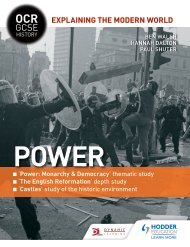GEOGRAPHY
WJEC-Eduqas-B-GCSE-Geography-sample-material
WJEC-Eduqas-B-GCSE-Geography-sample-material
Create successful ePaper yourself
Turn your PDF publications into a flip-book with our unique Google optimized e-Paper software.
THEME 1 CHANGING PLACES – CHANGING ECONOMIES<br />
Ethnic minorities in Cardiff<br />
Cardiff is a multicultural city. Between 1800 and the<br />
1930s economic migrants moved from other European<br />
countries and the countries of the British Empire to<br />
Cardiff. Many were sailors who worked on the ships<br />
that exported coal from South Wales. Most settled in<br />
Butetown, close to the docks, in an area that was then<br />
called Tiger Bay. Today, a total of 8 per cent of Cardiff’s<br />
population are members of ethnic minorities. People<br />
have settled in the city from over 50 different countries.<br />
The two largest communities are descended from South<br />
Asian (India, Pakistan and Bangladesh) and Somali<br />
migrants.<br />
The Somali population in Cardiff has a population<br />
estimated to be a little under 10,000. Most of them live<br />
in a relatively small neighbourhood within the inner urban<br />
area in the wards of Grangetown and Riverside. Somalis<br />
choose to live in this district to be close to other family<br />
members. The area has many shops that cater for the<br />
Muslim population such as halal butchers and fast food<br />
shops that sell food prepared using halal meat. The area<br />
has a number of mosques and Muslim cultural centres.<br />
This district also has a wide variety of different sized<br />
houses and flats for both rent and sale at a variety of<br />
prices.<br />
Figure 18 A shop in Riverside, Cardiff selling halal meat<br />
GEOGRAPHICAL SKILLS<br />
Describing distributions<br />
To describe a distribution is to describe how similar things are spread<br />
across a map. Geographers are interested in the distribution of<br />
natural features such as glaciers, coral reefs and volcanoes; as well as<br />
human features such as settlements, hospitals or sporting facilities.<br />
Describing a distribution requires you to do two things.<br />
1 You need to describe where on the map the features are located.<br />
For example, of the ten parks marked on Figure 19, the majority<br />
are in the northern suburbs of the city and only four are within<br />
the inner urban area.<br />
2 Describe any pattern the features might make. Distribution<br />
patterns usually fall into one of three types:<br />
Figure 19 Distribution patterns<br />
■■<br />
Regular, where the features are more or less equally spaced.<br />
■■<br />
Random, where the features are scattered across the map at irregular distances from each other.<br />
■■<br />
Clustered, where the features are grouped together into only one part of the map.<br />
In addition to this, some features make a linear pattern if they all fall along a line. Several parks in Cardiff<br />
make a linear pattern. The largest park follows the line of the River Taff as it enters the city in the north and<br />
flows southwards towards the city centre. The park makes a green corridor running north-south through<br />
the city.<br />
(a)<br />
(b)<br />
(c)<br />
(d)<br />
10




